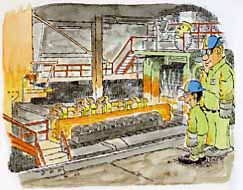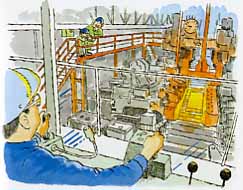


Now we come to the first step in manufacturing finished steel products. As you might expect, our rolling mills, bar mills, wire mills and other facilities cannot work with molten steel. Instead, they are designed to process large chunks of solidified steel.
Depending on size and shape, these chunks are called slabs, billets or blooms. All of these are classified as semifinished steel products because they are intended for subsequent finishing into sheet, strip, bars, wire and other salable products.
When a batch of molten steel leaves the BOF, open-hearth or electric furnace, it is usually poured into ingot molds and allowed to solidify. Then, the molds are stripped away. Each ingot weighs as much as 30 tons and stands about six feet high.
Next, the ingots are moved to soaking pits, especially designed furnaces that soak" the steel in a 2000+ F temperature for many hours.
When the temperature of an ingot is uniform throughout its entire mass, it is ready to be taken to the blooming mill.
The term bloom" stems from the old Anglo-Saxon word "bloma" which means a mass of iron. In modern steelmaking, bloom has come to mean a chunk of steel that has a square cross-section measuring more than six inches on each side.
A billet is similar to a bloom, except that its square cross-section is less than six inches high and wide.
A slab is a chunk of steel with an oblong cross-section, typically two to nine inches thick and 24 to 60 inches wide.
These terms are not very precise; it's often difficult to decide if a specific chunk of steel is a bloom or a billet.
All of these shapes are made in a blooming mill by squeezing a hot ingot between large steel rolls. Because the steel is white hot, it is soft and shapable (above).
The ingot passes back and forth through
the pair of rolls. Each pass reduces its cross-section area and
extends its length. The process is much like shaping a piece of
pie dough with a rolling pin. Finally, the blooms, billets or
slabs are cut to specified length.